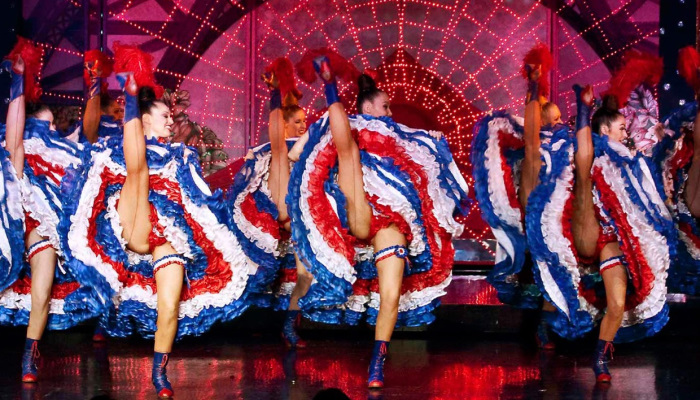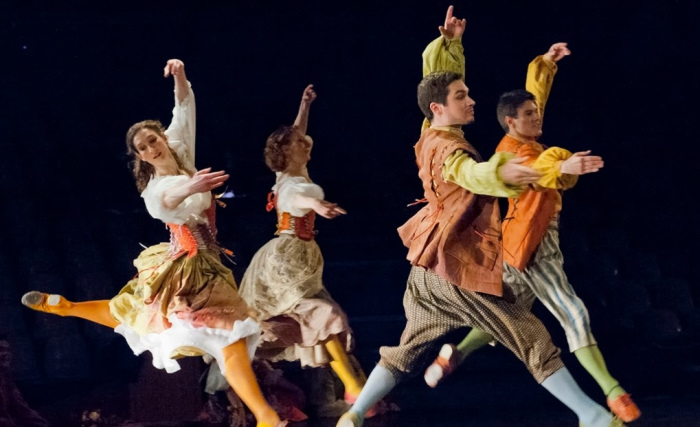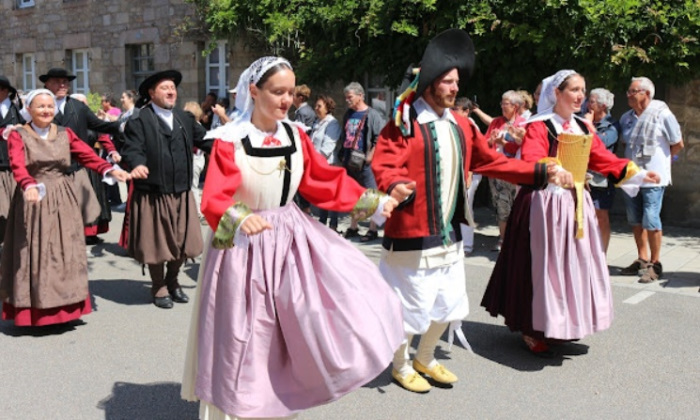France is a country with countless cultural icons, especially in the arts. Its people are highly proud and passionate about the traditional French dances they have created, adopted, and developed since the early days.
As dance enthusiasts, we should stay aware of these inspiring and influential dances!
Table of Contents
The Ultimate List Of Traditional French Dances
Allemande
“Allemande” can be directly translated to “German dance”, which indicates the origins of it rather clearly.
At first, it was a Baroque and Renaissance dance as well as an indispensable starter for a suite of Baroque dancers in the 16th century. However, the instructions from this time have disappeared with time.
In the later decades, the dancing master from French, Thoinot Arbeau, had an attempt to preserve Allemande.
Allemande dancers perform in pairs within the area of a ballroom. The participants will form two lines facing each other.
Their parade ranges across the room with lively steps and optional hops while they maintain an elegance suitable for aristocrats.
According to records, the popularity of Thoinot Arbeau’s Allemande decreased significantly in the next century, yet it actually changed in tempo.
For example, we have pavane in France, which is a slowed Allemande. German composers were keen on the traditional version, while English and Italian composers enjoyed getting creative with their pieces.
Apache Dance
It would be so foul to compile a list of French dances and ignore the street culture of the Parisians. Based on historical records that survived till our day, “Apaches” was the name for a group of brutal youngsters frequenting local bars.
Inspired by the aggressiveness in them, dancers Max Dearley and Maurice Mouvet created the Apache dance.
Male dancers will be dressed in rather casual clothes and a cap, they can also include a scarf around their neck or waist. The female outfit is quite similar except for the skirt setting them apart from what the men wear.
Mimicking the actions of a pimp and a prostitute, the dance isn’t for people who expect a romantic performance. It takes inspiration from punches and slaps, with the male lifting and tossing his partner onto the ground as well.
Aside from Paris, you won’t find centers and schools teaching this uniquely dramatic dance anywhere in the world.
Check more: 18 Traditional Colombian Dances
Bal-Musette
To write about old French dances without mentioning the Musette style would be impossible for any Frenchman.
It first appeared when the 20th century started and Italian inhabitants set their feet on Paris, and people originally referred to it as “bal des bougnats”.
During that era, Bal-Musette was a very informal dance for places like bars and restaurants, where everyone was welcome to join regardless of gender and social class. All it needed was a dance floor and a band.
Gradually, the dance was modified and separated into two types: ballroom dancing and waltz. The sounds of musette and bagpipes make up the most of music for Bal-Musette.
Eventually, accordions, double basses, and percussion instruments joined the band and became irreplaceable.
Compared to various dances of its time, Bal-Musette also lost its fame for a short while but recovered not so long after due to its casual and fun nature.
Bourrée
Bourrée is the name for a French dance along with the music and the words going with it. There was a resemblance between Bourrée and Gavotte, though it was visibly quicker.
It started as a French folk dance in the latter half of the 17th century. However, after the adoption of the Academie of Dance, it officially entered the society.
Without the widespread of an accessible cultural trait, it faded from the spotlight for a while but still made a comeback in the end.
The Bourrée formalized in classic ballet introduced en pointe (or demi-pointe) to form pas de bourrée, which is extremely well-known as the preparation step of a grand showcase.
The characteristics of Bourrée are fast-paced skipping steps. On certain occasions, the performers also wear wooden clogs so their movements will transform into lively sounds.
You’ll love: 8 Traditional Turkish Dances
Branle – The most ancient dance form in France
Originating in the 16th century and still popular till the present, Branle is probably the oldest in French dance history. Its name is derived from branler, a French verb standing for shake, sway, or wobble.
The most common formation in Branle is a chain consisting of couples holding hands or linking arms with others. They will move to the left and then to the right in sync, causing the entire chain to move as a whole.
Despite its beginning as a folk dance, Branle was also adopted by the aristocrats like many of its siblings.
Hence, modern dancers have the necessary documents to recognize and reconstruct the original Branle, although it has quite a lot of variations depending on the region.
Branle appeared in Shakespeare’s work and became even more popular in other countries at that time. It’s perhaps why Branle’s reputation has never dissipated.
Breton
Rather than a dance routine or movement, Breton is the term for a group of dance forms in Brittany from the 1800s, when people needed a reason to dance.
Aside from the most important events like weddings, celebratory dances might also take place when a new house is built, during a harvest festival, or as a religious practice.
In the middle of the 20th century, the Celtic Circles went through a remarkable development and thus created a rerun of the dance, to the point it turned into a primary factor of the contemporary expression of Breton culture.
You can enjoy two versions of the Breton dance: fest-noz typically includes young people, while old people are often present in fest-deiz.
Either way, the dancers will be accompanied by singers and musicians in bands of numerous scales. Of course, the old days were all about acoustic sounds and the modern days adopted electric tunes.
For people in Brittany, Brenton conveys an identity’s expression. Through dancing and singing, people share a happy time and leave everything else behind.
Aside from pure entertainment, it also stands for individual statuses through a collective activity.
Can-can

The French can-can is quite popular for dance lovers because of how physically demanding and energetic it is. From the music hall to French Cabaret, Can-can left its duo version behind and became an all-female chorus line.
Reliable sources believe Can-can is the evolved form of a social dance for couples named quadrille.
They cannot pinpoint the exact origins of the dance but they have found relations between its steps and a famous acrobatic and mime artist.
During its era, Can-can was seen as an inappropriate dance for women, for the movements tended to reveal too much of the dancer’s body, leading to many performers being arrested.
Although men performed Can-can more often, women’s versions were still always more well-known.
Since the 1890s, as dancers could truly become stars and earn enough for a living, the dance conveniently became more commonly seen and incorporated into different choreography pieces.
Chaconne

Originally read as “ciaconne”, Chaconne is a musical form from Spain in the 17th century, famous for its suggestive and feisty nature. Many records pointed out that the original Chaconne featured a solo female artist or a duo.
When spread to Italy, Chaconne was quite well-received as well. The reputation paved the way for it to be present at the French court despite the performance being quite subdued.
The music for Chaconne resembles a continuous, never-ending flow of a major key and triple meter on a harmonic progression or a short bass line.
The 19th century witnessed the end of the Baroque period and the decline of Chaconne. However, the next century marked its revival with nearly thirty composers making examples for it.
Contredanse
Also known as “contra dance”, it is a folk dance featuring a long line of couples.
While the mixed origins make it a bit difficult for us to tell where exactly Contredanse came from, we have proof of it developing remarkably in France from the 17th century.
Because it is a social dance, everyone can attend with or without a partner. They will form pairs first and the pairs form a line across the dance hall.
There needs to be a caller teaching the figures and keeping the formation steady.
Following up with the casual and carefree vibe, Contredanse doesn’t have a dress code. The performers don’t need any special outfits as long as they are comfortable with what they are.
The most common clothes for them are large shirts, flowy skirts, low-heeled shoes, and loose pants for men.
Contredanse artists can travel anywhere and find other talents at weekend conventions and dance camps.
Farandole
Although the name Farandole only came in use in the 18th century, its representation has appeared on rock gravings of prehistoric times, making it the oldest dance of Provence.
For the modern Farandole, the performers hold hands to create a chain and meet each beat of the music with a jump. It sounds relatively simple, though it still gave birth to various dance styles.
In today’s Provence, Farandole is still frequently performed for the Christmas crib and is still one of the signature activities here.
The accompaniment of galoubets and tambourines by drummers is one of the recognizable details about Farandole.
The dancers and the drummers in Farandole tend to wear the same white pants, white shirts, and a traditional red belt made of wool-like fabrics.
Since the drummer has an important position, they get to put on a hat and an embroidered waistcoat.
Gavotte
Gavot is the name for the people of Dauphiné, the southeast of France. People believe it is the origin of the Gavotte dance.
In other references, Gavotte might also be the term for a number of folk dances in Brittany or Provence.
By the end of the 16th century, Gavotte was introduced as a branles suite and became very popular during the court of Louis XIV.
More variations were born in the next century and in the 1800s, nearly the entire territory of France knew of Gavotte.
Compared to the Gavotte we have today, the most remarkable change lies in the music. It became more connected to us through the involvement of modern instruments and so much more freedom from the composers.
Gigue
Derived from the jig word in English, Gigue is an energetic dance originating from the Baroque period. Around the 1750s, the dance traveled to France and usually ended in a suite.
Although Gigue wasn’t a court dance, it was often performed on social gatherings by the elite class. Hence, the number of composers who wrote for Gigue was not any less than you imagined.
During the rest of the 18th history, Gigue became a norm in the ballroom scene. It was highly appreciated and favorited for the lively beats containing various groups of three quick moves.
In the old days, you will mostly see Gigue being performed by duos in traditional outfits, yet the formation and the dress code have all changed to serve our modern time.
Java Dance
Compared to the previous dances, Java is quite young with its beginning being traced back to the 20th century only. Many proofs indicated that the Java dance probably originated from the Valse.
In the first half of the previous century, the communities direly needed a new waltz, preferably something faster and more sensual, yet also easier to learn and not demanding a large hall like traditional waltzes.
In Java, the dancers will perform in a duo and maintain an intimate distance while executing small but quick steps.
Most of the time, the male will keep both hands on the female’s bottom. Hence, some strict dance halls forbid performers from dancing this type.
Maraîchine
Even though Maraîchine isn’t as popular as other dances, the creation of the north side was still worth mentioning for the inspiration it possesses.
Maraîchine came from Bretagne and Poitou, the northwest regions of France known for being the origin of various dances inspired by Celtic culture. Its standard formation consists of couples joining hands in a circle.
The routine mostly includes forward and backward steps to get the circle moving while the performers swing their arms together for a rather joyous atmosphere.
Some modified social dances might require the male to hold the female’s hand and keep their joined palms at waist level.
Menuet
Also known as Minuet, it is a derivative of the corresponding traditional French dance music for two people. This music has been developed rather well and became part of the classical symphony in its early days.
Since the later 17th century, Menuet has dominated ballrooms for aristocrats with its small steps. Rather than speeding up, its movements grow slower and laden with etiquette.
Menuet dancers often perform in an order of special positions and have individual choreography including but not limited to floor patterns and turns, occasionally added with curtsies and bows to spectators.
Rigaudon
Also referred to as Rigadon or Rigadoon, Rigaudon is a Baroque dance from France, recognized by the unique duple meter.
It appeared in the 17th century as a folk dance couples could enjoy together and created a name for itself in the south side of France. In the court of Louis XIV, Rigaudon gradually became more well-known as a court dance.
The talented French and English court dancers significantly modified and improved Rigaudon as a simple and lively routine, thus staying popular for the next century.
Later on, it had to give up the popular title to none other than the Menuet dance.
Sarabande
Sarabande is a Spanish dance with Arabic traits, known for couples with castanets forming a line.
Considered an indecent dance by the priests, there was a time when the dance was banned and only performed in secret or mentioned in literature.
Nonetheless, things changed once it was brought to France in the Baroque time infused with classic music. The French Sarabande became a slow court dance instead.
After a decline, Sarabande recovered at the end of the 1900s, thanks to numerous composers writing for its music. The dance even contributed to La hija de Cólquide, a ballet by Carlos Chávez.
Tourdion
Meaning “twist” in English, Tourdion is a lively French dance that has existed since the middle of the 1400s. It traveled from the Burgundian court to the French court.
Tourdion is usually performed along with Pavane, Galliard, Allemande, and Courante due to their similar nature. When a contrast is needed, the choreography might include Basse.
There have been various versions of Tourdion, though most of them include simple footwork. The dancers need to distribute their weights on both feet evenly and balance themselves for high kicks and jumps.
The steps in Tourdion were created for couples, and the performance typically included four or five pairs at most.
Valse Musette
To many people, the Valse Musette is an incorrect term for the Parisian Waltz during the Age of Jazz. Its tempo ranges from relaxingly slow to extremely fast, though neither of them is truly difficult to catch up.
In Valse Musette, the distance between two dancers is reduced to near-zero, unless they are performing in a ballroom, where an embrace wouldn’t be approved.
The man can keep both hands hovering over the small of his partner’s back or put one hand on her and keep the other on his side.
The appeal of Valse Musette lies within the variety of movements that can be included. There are no fixed techniques to a step, hence the dancers are free to add a little bit of themselves to every move they make.
Final Words
These dances are certainly not all of the traditional French dances that France has had during its long history of culture and art.
However, one is bound to find something compatible with their taste or ability, whether it is a folk dance from a distant region or a court dance that has charmed the aristocrats before!


